Dongseok Shim
Seoul National University
MVLight: Relightable Text-to-3D Generation via Light-conditioned Multi-View Diffusion
Nov 18, 2024Abstract:Recent advancements in text-to-3D generation, building on the success of high-performance text-to-image generative models, have made it possible to create imaginative and richly textured 3D objects from textual descriptions. However, a key challenge remains in effectively decoupling light-independent and lighting-dependent components to enhance the quality of generated 3D models and their relighting performance. In this paper, we present MVLight, a novel light-conditioned multi-view diffusion model that explicitly integrates lighting conditions directly into the generation process. This enables the model to synthesize high-quality images that faithfully reflect the specified lighting environment across multiple camera views. By leveraging this capability to Score Distillation Sampling (SDS), we can effectively synthesize 3D models with improved geometric precision and relighting capabilities. We validate the effectiveness of MVLight through extensive experiments and a user study.
Magnituder Layers for Implicit Neural Representations in 3D
Oct 13, 2024



Abstract:Improving the efficiency and performance of implicit neural representations in 3D, particularly Neural Radiance Fields (NeRF) and Signed Distance Fields (SDF) is crucial for enabling their use in real-time applications. These models, while capable of generating photo-realistic novel views and detailed 3D reconstructions, often suffer from high computational costs and slow inference times. To address this, we introduce a novel neural network layer called the "magnituder", designed to reduce the number of training parameters in these models without sacrificing their expressive power. By integrating magnituders into standard feed-forward layer stacks, we achieve improved inference speed and adaptability. Furthermore, our approach enables a zero-shot performance boost in trained implicit neural representation models through layer-wise knowledge transfer without backpropagation, leading to more efficient scene reconstruction in dynamic environments.
Object Remover Performance Evaluation Methods using Class-wise Object Removal Images
Apr 17, 2024



Abstract:Object removal refers to the process of erasing designated objects from an image while preserving the overall appearance, and it is one area where image inpainting is widely used in real-world applications. The performance of an object remover is quantitatively evaluated by measuring the quality of object removal results, similar to how the performance of an image inpainter is gauged. Current works reporting quantitative performance evaluations utilize original images as references. In this letter, to validate the current evaluation methods cannot properly evaluate the performance of an object remover, we create a dataset with object removal ground truth and compare the evaluations made by the current methods using original images to those utilizing object removal ground truth images. The disparities between two evaluation sets validate that the current methods are not suitable for measuring the performance of an object remover. Additionally, we propose new evaluation methods tailored to gauge the performance of an object remover. The proposed methods evaluate the performance through class-wise object removal results and utilize images without the target class objects as a comparison set. We confirm that the proposed methods can make judgments consistent with human evaluators in the COCO dataset, and that they can produce measurements aligning with those using object removal ground truth in the self-acquired dataset.
AURA : Automatic Mask Generator using Randomized Input Sampling for Object Removal
May 13, 2023
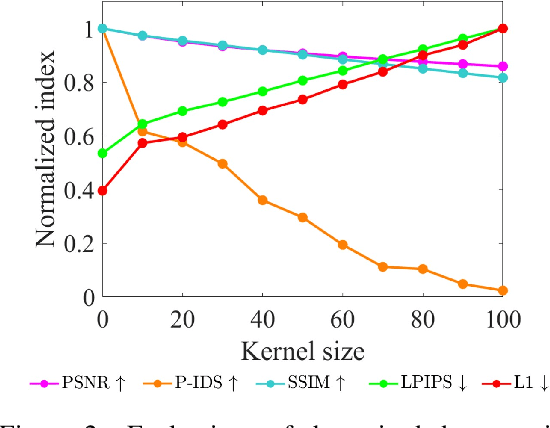

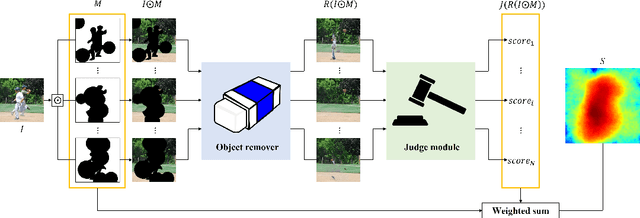
Abstract:The objective of the image inpainting task is to fill missing regions of an image in a visually plausible way. Recently, deep-learning-based image inpainting networks have generated outstanding results, and some utilize their models as object removers by masking unwanted objects in an image. However, while trying to better remove objects using their networks, the previous works pay less attention to the importance of the input mask. In this paper, we focus on generating the input mask to better remove objects using the off-the-shelf image inpainting network. We propose an automatic mask generator inspired by the explainable AI (XAI) method, whose output can better remove objects than a semantic segmentation mask. The proposed method generates an importance map using randomly sampled input masks and quantitatively estimated scores of the completed images obtained from the random masks. The output mask is selected by a judge module among the candidate masks which are generated from the importance map. We design the judge module to quantitatively estimate the quality of the object removal results. In addition, we empirically find that the evaluation methods used in the previous works reporting object removal results are not appropriate for estimating the performance of an object remover. Therefore, we propose new evaluation metrics (FID$^*$ and U-IDS$^*$) to properly evaluate the quality of object removers. Experiments confirm that our method shows better performance in removing target class objects than the masks generated from the semantic segmentation maps, and the two proposed metrics make judgments consistent with humans.
SNeRL: Semantic-aware Neural Radiance Fields for Reinforcement Learning
Jan 27, 2023Abstract:As previous representations for reinforcement learning cannot effectively incorporate a human-intuitive understanding of the 3D environment, they usually suffer from sub-optimal performances. In this paper, we present Semantic-aware Neural Radiance Fields for Reinforcement Learning (SNeRL), which jointly optimizes semantic-aware neural radiance fields (NeRF) with a convolutional encoder to learn 3D-aware neural implicit representation from multi-view images. We introduce 3D semantic and distilled feature fields in parallel to the RGB radiance fields in NeRF to learn semantic and object-centric representation for reinforcement learning. SNeRL outperforms not only previous pixel-based representations but also recent 3D-aware representations both in model-free and model-based reinforcement learning.
SwinDepth: Unsupervised Depth Estimation using Monocular Sequences via Swin Transformer and Densely Cascaded Network
Jan 17, 2023Abstract:Monocular depth estimation plays a critical role in various computer vision and robotics applications such as localization, mapping, and 3D object detection. Recently, learning-based algorithms achieve huge success in depth estimation by training models with a large amount of data in a supervised manner. However, it is challenging to acquire dense ground truth depth labels for supervised training, and the unsupervised depth estimation using monocular sequences emerges as a promising alternative. Unfortunately, most studies on unsupervised depth estimation explore loss functions or occlusion masks, and there is little change in model architecture in that ConvNet-based encoder-decoder structure becomes a de-facto standard for depth estimation. In this paper, we employ a convolution-free Swin Transformer as an image feature extractor so that the network can capture both local geometric features and global semantic features for depth estimation. Also, we propose a Densely Cascaded Multi-scale Network (DCMNet) that connects every feature map directly with another from different scales via a top-down cascade pathway. This densely cascaded connectivity reinforces the interconnection between decoding layers and produces high-quality multi-scale depth outputs. The experiments on two different datasets, KITTI and Make3D, demonstrate that our proposed method outperforms existing state-of-the-art unsupervised algorithms.
DiffuPose: Monocular 3D Human Pose Estimation via Denoising Diffusion Probabilistic Model
Dec 09, 2022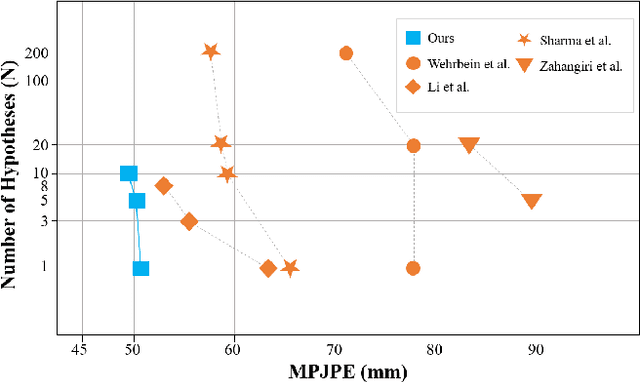


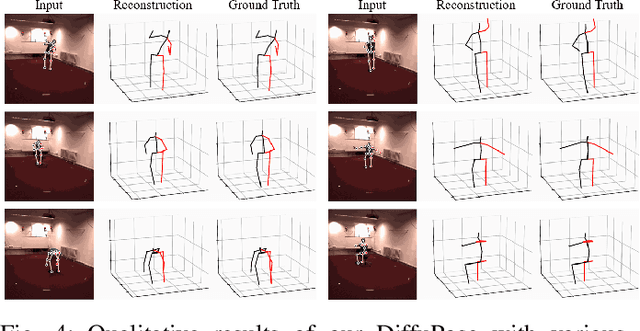
Abstract:Thanks to the development of 2D keypoint detectors, monocular 3D human pose estimation (HPE) via 2D-to-3D uplifting approaches have achieved remarkable improvements. Still, monocular 3D HPE is a challenging problem due to the inherent depth ambiguities and occlusions. To handle this problem, many previous works exploit temporal information to mitigate such difficulties. However, there are many real-world applications where frame sequences are not accessible. This paper focuses on reconstructing a 3D pose from a single 2D keypoint detection. Rather than exploiting temporal information, we alleviate the depth ambiguity by generating multiple 3D pose candidates which can be mapped to an identical 2D keypoint. We build a novel diffusion-based framework to effectively sample diverse 3D poses from an off-the-shelf 2D detector. By considering the correlation between human joints by replacing the conventional denoising U-Net with graph convolutional network, our approach accomplishes further performance improvements. We evaluate our method on the widely adopted Human3.6M and HumanEva-I datasets. Comprehensive experiments are conducted to prove the efficacy of the proposed method, and they confirm that our model outperforms state-of-the-art multi-hypothesis 3D HPE methods.
S2P: State-conditioned Image Synthesis for Data Augmentation in Offline Reinforcement Learning
Sep 30, 2022



Abstract:Offline reinforcement learning (Offline RL) suffers from the innate distributional shift as it cannot interact with the physical environment during training. To alleviate such limitation, state-based offline RL leverages a learned dynamics model from the logged experience and augments the predicted state transition to extend the data distribution. For exploiting such benefit also on the image-based RL, we firstly propose a generative model, S2P (State2Pixel), which synthesizes the raw pixel of the agent from its corresponding state. It enables bridging the gap between the state and the image domain in RL algorithms, and virtually exploring unseen image distribution via model-based transition in the state space. Through experiments, we confirm that our S2P-based image synthesis not only improves the image-based offline RL performance but also shows powerful generalization capability on unseen tasks.
FS-NCSR: Increasing Diversity of the Super-Resolution Space via Frequency Separation and Noise-Conditioned Normalizing Flow
Apr 20, 2022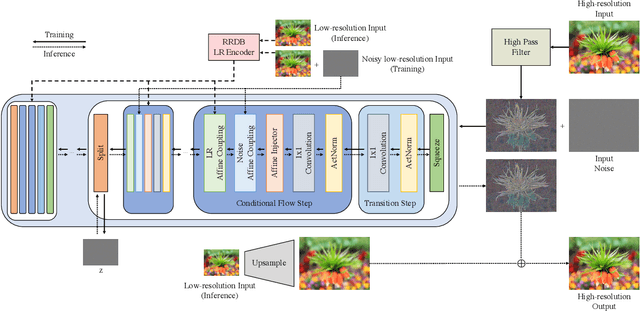
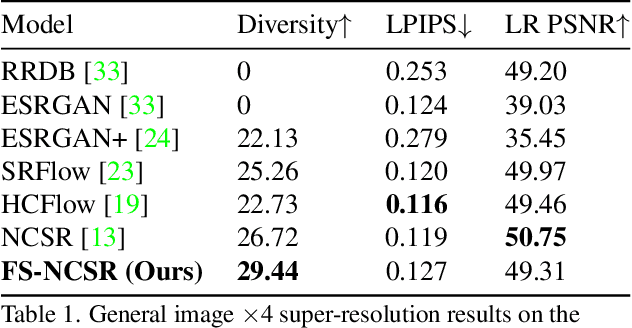
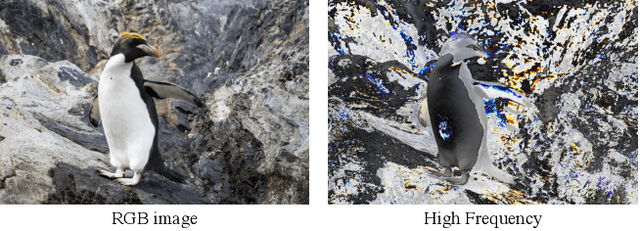
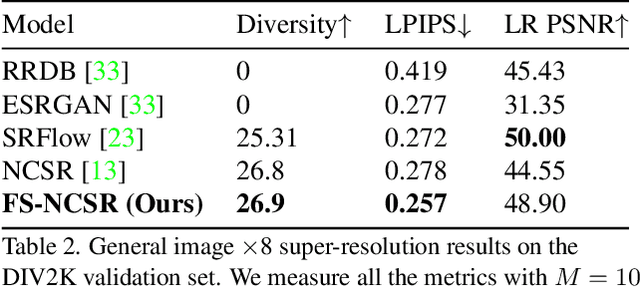
Abstract:Super-resolution suffers from an innate ill-posed problem that a single low-resolution (LR) image can be from multiple high-resolution (HR) images. Recent studies on the flow-based algorithm solve this ill-posedness by learning the super-resolution space and predicting diverse HR outputs. Unfortunately, the diversity of the super-resolution outputs is still unsatisfactory, and the outputs from the flow-based model usually suffer from undesired artifacts which causes low-quality outputs. In this paper, we propose FS-NCSR which produces diverse and high-quality super-resolution outputs using frequency separation and noise conditioning compared to the existing flow-based approaches. As the sharpness and high-quality detail of the image rely on its high-frequency information, FS-NCSR only estimates the high-frequency information of the high-resolution outputs without redundant low-frequency components. Through this, FS-NCSR significantly improves the diversity score without significant image quality degradation compared to the NCSR, the winner of the previous NTIRE 2021 challenge.
Learning a Domain-Agnostic Visual Representation for Autonomous Driving via Contrastive Loss
Mar 10, 2021



Abstract:Deep neural networks have been widely studied in autonomous driving applications such as semantic segmentation or depth estimation. However, training a neural network in a supervised manner requires a large amount of annotated labels which are expensive and time-consuming to collect. Recent studies leverage synthetic data collected from a virtual environment which are much easier to acquire and more accurate compared to data from the real world, but they usually suffer from poor generalization due to the inherent domain shift problem. In this paper, we propose a Domain-Agnostic Contrastive Learning (DACL) which is a two-stage unsupervised domain adaptation framework with cyclic adversarial training and contrastive loss. DACL leads the neural network to learn domain-agnostic representation to overcome performance degradation when there exists a difference between training and test data distribution. Our proposed approach achieves better performance in the monocular depth estimation task compared to previous state-of-the-art methods and also shows effectiveness in the semantic segmentation task.
 Add to Chrome
Add to Chrome Add to Firefox
Add to Firefox Add to Edge
Add to Edge